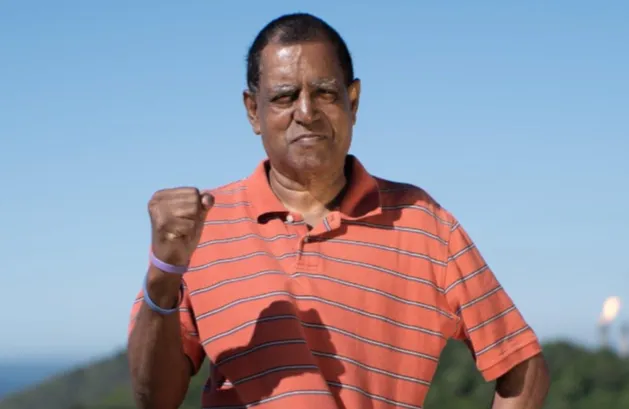South Durban community demands action on air quality monitoring
Vulnerable population at risk

Desmond D'Sa
Image: Supplied
THE South Durban Community Environmental Alliance (Sdcea) is calling for the immediate repair and expansion of ambient air quality monitoring stations operated by the Department of Economic Development, Tourism and Environmental Affairs (EDTEA).
The organisation's air quality and health officer, Bongani Mthembu, said in a bid to resolve the air quality issues, EDTEA needed transparent emissions data sharing from industries, a policy enforcement with real penalties for polluters, and community involvement in environmental decision-making.
“We also call for the support of clean energy alternatives and emissions reduction technology, and a dedicated health response unit in affected areas.
“Without functioning air quality monitoring stations, it becomes extremely difficult to detect, record, or respond to pollution spikes in real-time. This puts vulnerable populations such as children, the elderly, and people with pre-existing health conditions at greater risk. It also hampers efforts to hold polluters accountable and limits the data available for policy-making and community advocacy,” he added.
Mthembu said communities in highly industrialised zones like south Durban, which included Merebank, Wentworth, Bluff, and Clairwood, were most at risk. “Other affected areas include Isipingo, Umbilo, Umkomaas, Richards Bay, and parts of Newcastle. These communities face exposure to harmful pollutants from petrochemical industries, paper mills, coal mines, and transport corridors.
“Our main concerns include the lack of enforcement and transparency from polluting industries, the inadequate response from government agencies - including EDTEA, the health impacts especially increased respiratory illnesses and cancers, and the failure to consult communities before decisions like refinery closures or repurposing.
“EDTEA's efforts have been largely inadequate and reactive. The lack of staffing and resources severely limits their capacity. Their response is often delayed, non-transparent, and lacks urgency. There is also insufficient community engagement and follow-through.
"KZN is a vast and industrially diverse province. One air quality officer is grossly insufficient. The challenges include the inability to cover multiple regions effectively, delayed responses to pollution complaints, weak compliance monitoring and enforcement and the lack of proactive inspection or community engagement,” Mthembu added.
He said in the past year, Sdcea had responded to about 60 call-outs for air quality concerns, particularly in south Durban and surrounding areas like Merebank, Wentworth, Bluff and Umkomaas.
“These included cases of odour complaints, flaring events, and visible emissions from industries. We conduct air quality testing proactively, as part of awareness campaigns and ongoing monitoring. We also do testing reactively, in response to community complaints, odour incidents, visible emissions, or during health crises. Seasonally, we test the air quality depending on changes in weather or industrial activity patterns,” he added.
Sdcea conducts passive air quality sampling, particularly for Volatile Organic Compounds (VOCs), Sulphur Dioxide (SO₂), and Nitrogen Dioxide (NO₂).
Mthembu said passive samplers had been deployed for two to four weeks at strategic community locations, which are often schools, households, or pollution hotspots.
The air quality analysis results are disseminated through community workshops or public reports. The findings are often used to advocate for government and industry accountability.
“The main causes of air pollution in the South Durban area are emissions from petrochemical industries like refineries and chemical plants, transport emissions from heavy-duty trucks and congested roads, and illegal or unregulated burning, including landfill fires.
“Air quality testing was last conducted in early 2025 in areas including Merebank, Wentworth, and Bluff. The air samples were taken in Clairwood and Jacobs after residents reported symptoms such as headaches, breathing difficulty, and skin irritation.
“Communities have reported health problems for decades. Durban south children suffer more from asthma, chronic cough, and respiratory infections. Residents continue to face high rates of asthma and bronchitis, especially in children. Cancers, including leukemia and lung cancer, skin and eye irritation, and mental health impacts, including stress and anxiety from continuous exposure, have also been noted. There has been no help from EDTEA for residents,” Mthembu added.
Sdcea’s founder, Desmond D’Sa, said a study conducted at Settlers Primary School in Merebank indicated that the asthma rate was 54.5%, with more than half of the percentage of children presenting with chronic asthma.
“The children in south Durban experienced breathing in more toxic pollutants from the petrol and chemical industry that affected their quality of life and health issues such as asthma.
“Their education suffered because they were taken regularly to the local doctor, clinic and or hospital because they struggled from breathing. Most of our residents are on nebulizers or need oxygen. We have had cases where children and adults have died due to breathing problems.
“We hosted five health assessments last year, in different areas in south Durban. We witnessed a number of asthma and cancer patients coming through to check their health, especially their heart, skin, chest, pressure and sugar. Through this ongoing dialogue and engagement we found that many of our residents both young and old, struggle with breathing, high blood pressure and struggle with heart palpitations, coughing, vomiting and nausea,” D’Sa said.